There’s something undeniably magical about the combination of white and blue in bedroom design. This timeless color pairing evokes feelings of serenity, cleanliness, and coastal tranquility that can transform any sleeping space into a peaceful retreat.
Whether you’re drawn to the crisp freshness of navy and white stripes or the soft romance of powder blue accents, these colors work harmoniously to create environments that promote rest and relaxation.
White serves as the perfect neutral foundation, making spaces feel larger and brighter while providing endless versatility for decorating.
Blue, in its many shades, brings depth, sophistication, and a calming psychological effect that’s scientifically proven to lower blood pressure and heart rate.
White and Blue Bedroom Ideas
From bold statement walls to subtle textile accents, the possibilities for incorporating these colors are endless.
The beauty of this combination lies in its adaptability – it works equally well in modern minimalist settings, traditional country homes, or luxurious master suites.
1. Classic Navy and Crisp White Combination
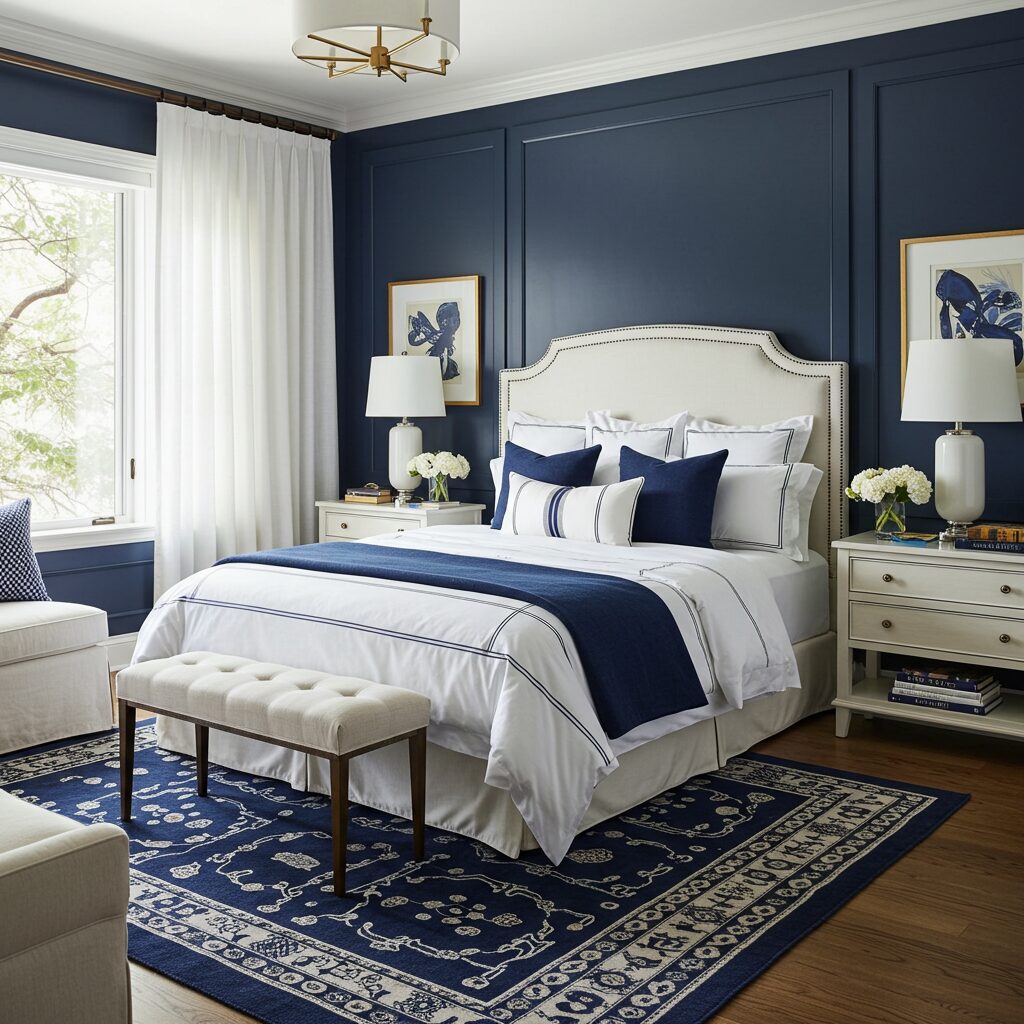
The navy and white pairing never goes out of style, offering a sophisticated foundation that works in any bedroom size. This combination creates a striking contrast that feels both bold and calming simultaneously. Navy walls paired with white bedding and furniture create a dramatic backdrop that doesn’t overwhelm the space.
The key to mastering this look lies in balancing the dark and light elements throughout the room. Consider using navy as an accent wall behind the headboard while keeping the remaining walls white to maintain brightness. White furniture pieces like dressers and nightstands help break up the darker tones and add visual interest.
For the finishing touches, incorporate navy blue throw pillows, curtains, or artwork to tie the color scheme together. The contrast between these two colors creates a timeless elegance that works beautifully with both modern and traditional furniture styles.
As someone who has designed countless bedrooms, I find this combination works particularly well in smaller spaces because the white elements prevent the navy from making the room feel cramped.
2. Powder Blue Walls with White Accents

Powder blue creates an incredibly soothing atmosphere that’s perfect for promoting restful sleep. This soft, muted shade of blue works beautifully on all four walls, creating a cocoon-like feeling that’s both calming and sophisticated. The gentle hue reflects light beautifully, making even smaller bedrooms feel more spacious and airy.
White accents become the perfect complement to powder blue walls, creating a fresh and clean aesthetic. Consider white bedding, furniture, and window treatments to brighten the space and prevent it from feeling too monochromatic. The contrast isn’t harsh like with navy, but rather creates a gentle, harmonious flow throughout the room.
Metallic accents in gold or silver work particularly well with this combination, adding a touch of elegance without overwhelming the serene atmosphere. Table lamps with white shades and metallic bases can provide both function and style while maintaining the room’s peaceful ambiance.
Pro Tip: When using powder blue on walls, choose a shade with gray undertones rather than green undertones for a more sophisticated, modern look that won’t feel dated.
3. Blue and White Striped Patterns
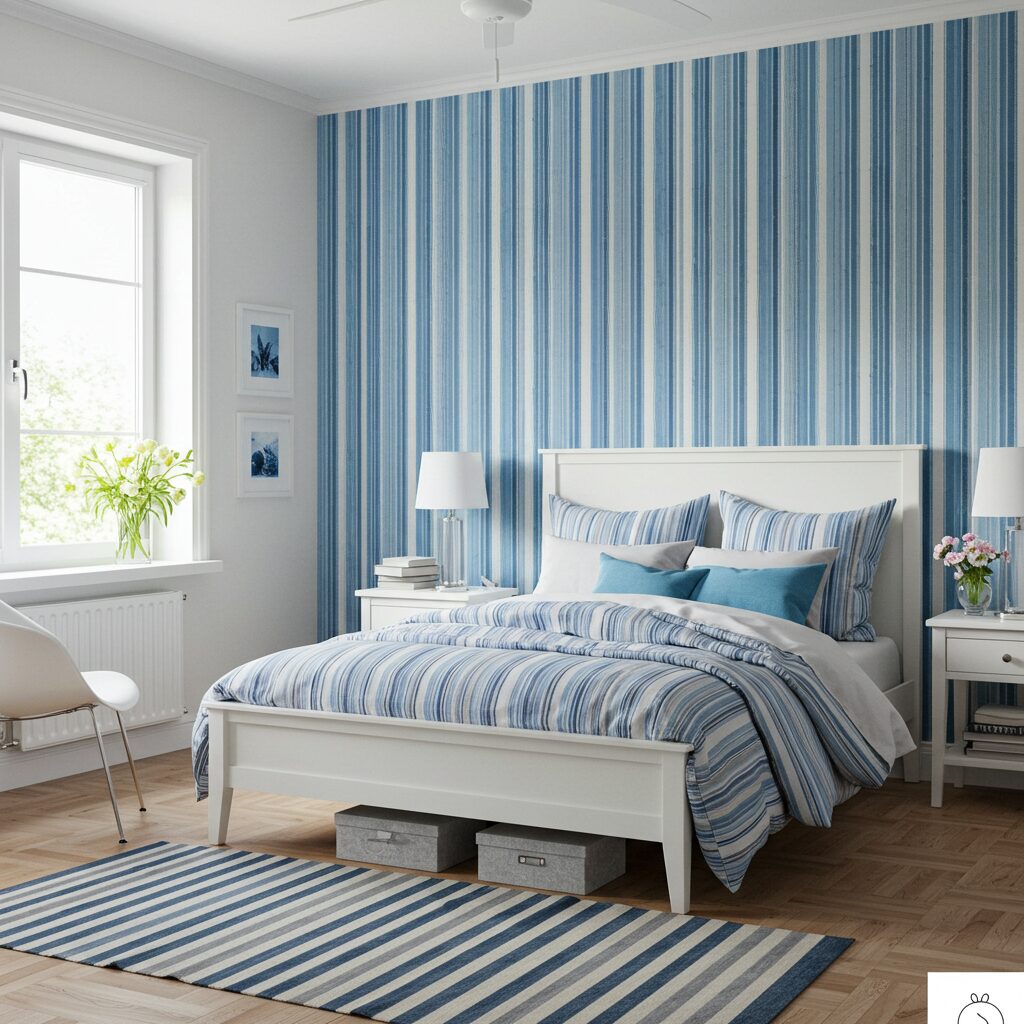
Stripes bring energy and visual interest to any bedroom while maintaining the classic appeal of blue and white. Whether you choose vertical stripes to make ceilings appear higher or horizontal stripes to make walls seem wider, this pattern adds dimension and personality to your space. The key is choosing the right scale for your room size and desired impact.
For a bold statement, consider using blue and white striped wallpaper on an accent wall behind the headboard. This creates a focal point without overwhelming the entire space. Alternatively, incorporate stripes through bedding, curtains, or upholstery for a more subtle approach that can be easily changed when you want to refresh the look.
The beauty of striped patterns lies in their versatility – thin pinstripes create a sophisticated, tailored look while wider stripes feel more casual and relaxed. Mix different stripe widths throughout the room in pillows, throws, and accessories to create visual depth and interest.
Stripes can be tricky – I always recommend starting with one major striped element and then adding smaller striped accessories to avoid creating a chaotic look.
4. Coastal Blue with Whitewashed Furniture

Bring the seaside indoors with coastal blue hues paired with whitewashed or distressed white furniture. This combination creates a relaxed, beachy atmosphere that feels vacation-ready year-round. The weathered look of whitewashed pieces adds character and charm while maintaining the light, airy feel essential to coastal design.
Coastal blue encompasses everything from soft aqua to deeper ocean blues, allowing you to customize the intensity based on your preferences. This shade works beautifully as an accent wall, in bedding, or through decorative accessories like lamps and artwork. The organic, slightly imperfect nature of whitewashed furniture complements the relaxed coastal vibe perfectly.
Natural textures like jute rugs, woven baskets, and linen fabrics enhance the coastal theme while maintaining the blue and white color scheme. These elements add warmth and prevent the room from feeling too sterile or cold.
Note: The key to authentic coastal style is embracing imperfection – furniture should look naturally weathered, not artificially distressed.
5. Royal Blue Statement Wall
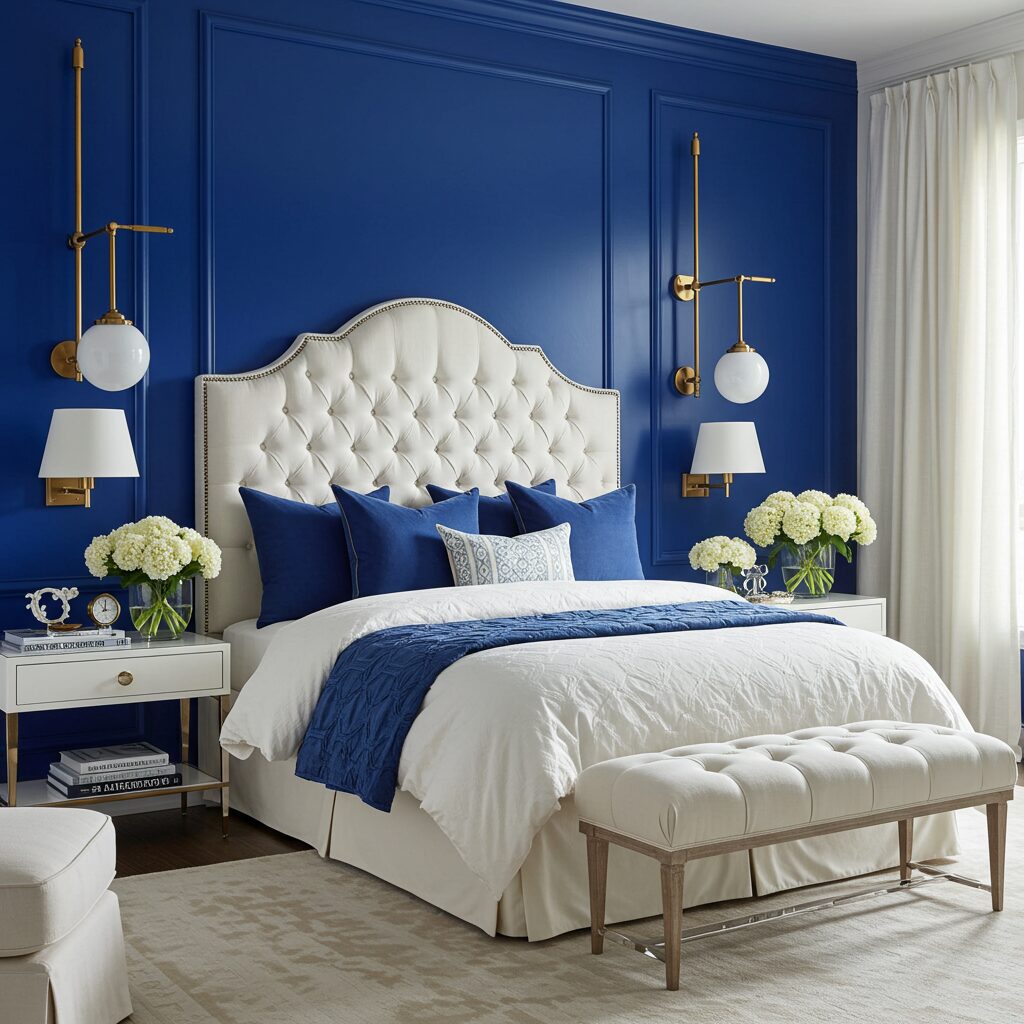
A royal blue statement wall creates drama and sophistication while serving as a stunning backdrop for white and neutral furnishings. This rich, deep blue commands attention and creates a luxurious atmosphere that’s perfect for master bedrooms. The intensity of royal blue requires careful balance with lighter elements to prevent the space from feeling too dark or overwhelming.
Position the statement wall behind the headboard to create a natural focal point that draws the eye and anchors the room’s design. White bedding becomes even more striking against this dramatic backdrop, while gold or brass accents add warmth and elegance. The contrast between the bold wall and crisp white elements creates a sophisticated, hotel-like atmosphere.
Lighting becomes crucial with such a dark accent wall – ensure adequate ambient and task lighting to prevent the space from feeling cave-like. Table lamps with white shades and metallic bases work beautifully, as do overhead fixtures that cast warm, inviting light throughout the room.
Tip: When using such a bold color, keep 70% of the room neutral to maintain balance and prevent the space from feeling overwhelming.
6. Light Blue Ceiling with White Walls
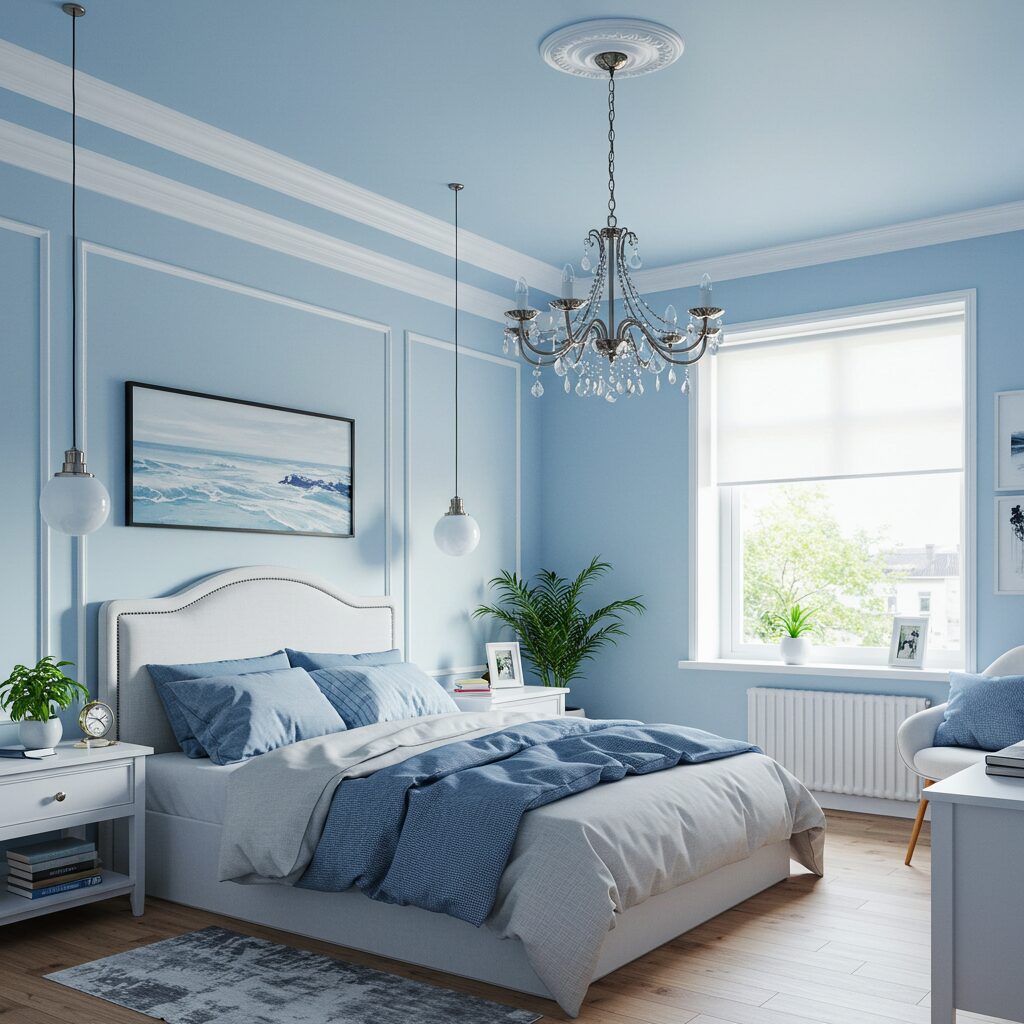
Transform your bedroom into a dreamy sanctuary by painting the ceiling a soft light blue while keeping walls pristine white. This unexpected design choice creates the illusion of an endless sky above your bed, promoting feelings of openness and tranquility. The technique works particularly well in rooms with higher ceilings but can make standard-height ceilings feel more spacious too.
The psychological effect of a blue ceiling cannot be overstated – it creates a sense of floating on clouds and can significantly improve sleep quality. White walls ensure the room remains bright and airy while allowing the ceiling to become a gentle focal point. This combination works beautifully with both modern and traditional furniture styles.
Consider adding white crown molding to create a clean transition between the blue ceiling and white walls. This architectural detail adds elegance while emphasizing the color contrast. Subtle lighting fixtures in brushed nickel or white finishes complement the color scheme without competing for attention.
This technique is my secret weapon for making any bedroom feel more luxurious and spacious without major renovations.
7. Denim Blue Textiles and White Linens
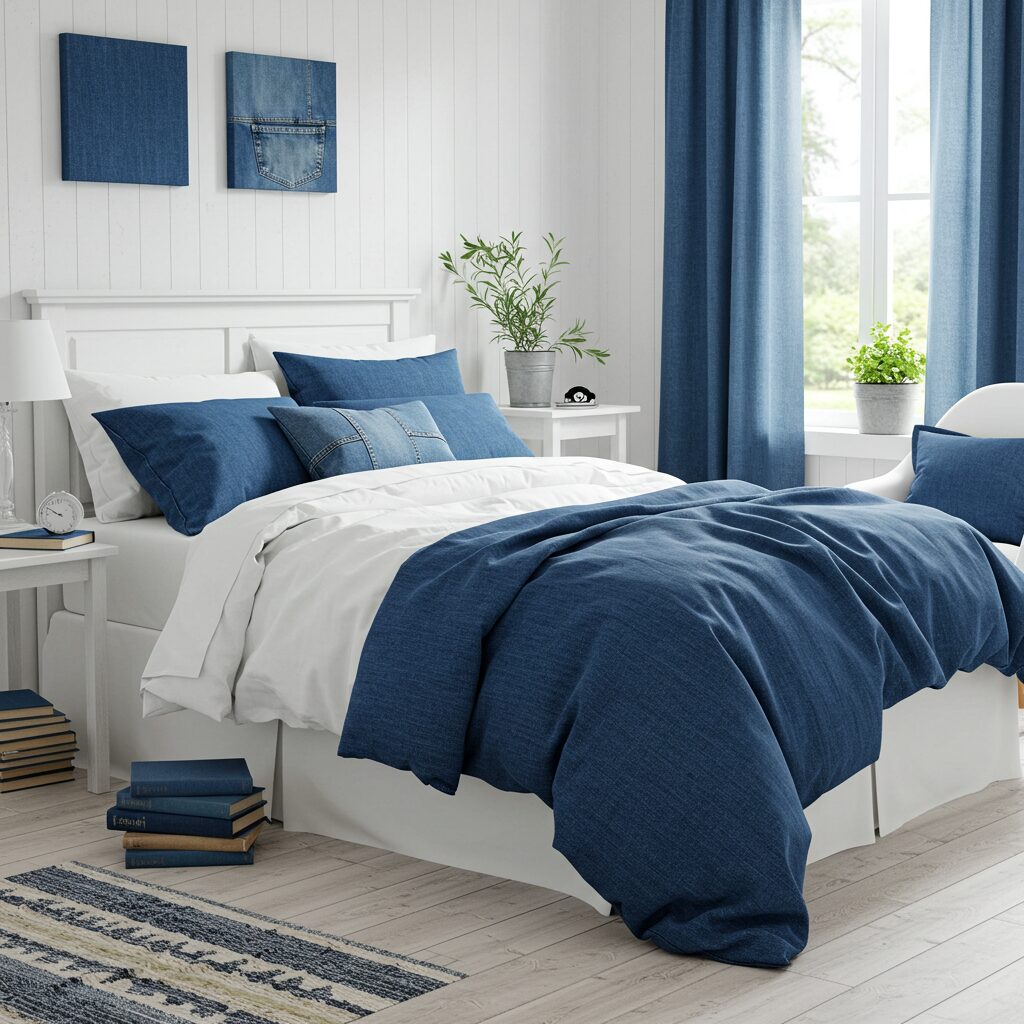
Incorporate the casual comfort of denim blue through textiles while maintaining sophistication with crisp white linens. This combination brings a relaxed, lived-in feeling that’s perfect for everyday comfort while still looking polished and intentional. Denim blue offers versatility in both its darker and lighter washes, each creating a different mood in the space.
Layer different denim blue textiles like throw pillows, blankets, and curtains against a backdrop of white walls and bedding. The varied textures and tones of denim create visual interest while maintaining a cohesive color story. Consider mixing smooth denim with more textured options like chambray or denim-inspired patterns for added depth.
White linens provide the perfect contrast to denim’s casual nature, elevating the overall look and preventing it from feeling too informal. Choose high-quality white sheets and pillowcases to create a hotel-like crispness that balances the relaxed denim elements beautifully.
Pro Tip: Mix different washes of denim blue – light, medium, and dark – to create depth and prevent the room from looking flat or one-dimensional.
8. Ice Blue and Warm White Combination
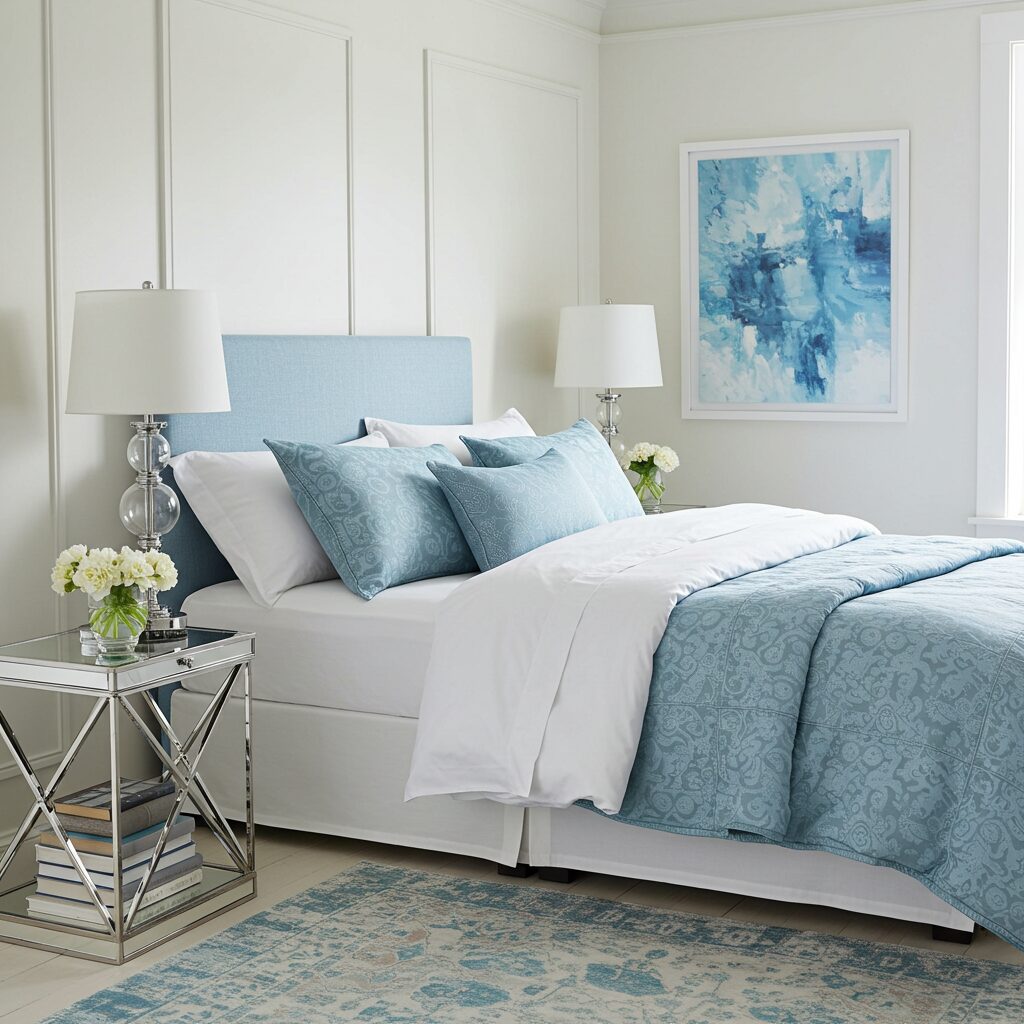
Ice blue paired with warm white creates a sophisticated color palette that feels both cool and inviting. This subtle combination works beautifully for those who want the calming effects of blue without overwhelming color presence. Ice blue’s gray undertones make it incredibly versatile and easy to live with long-term.
The key to this combination lies in choosing the right shade of white – warm whites with creamy or ivory undertones complement ice blue better than stark bright whites. This creates a more cohesive, harmonious look that feels intentional rather than accidental. The overall effect is serene and spa-like.
The beauty of this combination is its timeless quality – it will never look dated and works with virtually any decorating style.
9. Bold Blue Headboard Feature

Make your bed the room’s centerpiece with a bold blue upholstered headboard that commands attention while maintaining the classic blue and white theme. A statement headboard serves as functional art, providing both comfort and visual impact. Choose from navy, royal blue, or even a rich teal to create the perfect focal point for your space.
The beauty of a blue headboard lies in its ability to anchor the entire room’s color scheme while providing flexibility in other decorative choices. White bedding creates a crisp contrast, while blue accent pillows can tie the look together without overwhelming the space. This approach allows you to keep walls neutral while still achieving significant color impact.
Consider the headboard’s texture and fabric carefully – velvet creates luxury, linen feels casual and relaxed, while leather adds sophistication. The scale should be proportional to your room size, with larger rooms accommodating more dramatic, oversized options.
Note: When investing in a statement headboard, choose a classic shape and high-quality fabric – this piece should last for years and work with evolving decor.
10. Vintage Blue and White Florals

Embrace timeless romance with vintage-inspired blue and white floral patterns that bring charm and personality to your bedroom. These classic patterns work beautifully in traditional, farmhouse, or shabby chic decorating styles. The key is choosing florals that feel authentic rather than overly cute or childish.
Toile patterns, delicate forget-me-nots, or classic chinoiserie designs in blue and white create sophisticated pattern play. Use these florals sparingly as accent pieces – perhaps in curtains, a throw pillow, or an upholstered chair – to avoid overwhelming the space. Balance patterned elements with solid blue and white pieces for a cohesive look.
Vintage-inspired florals pair beautifully with antique or distressed furniture pieces, creating a collected-over-time aesthetic. Mix different scales of floral patterns throughout the room, ensuring they share the same color palette for cohesion.
Floral patterns can quickly become overwhelming – I recommend following the rule of one large floral element plus two smaller ones maximum.
11. Monochromatic Blue Gradient

Create visual interest through a monochromatic blue gradient that transitions from deep navy to soft powder blue throughout the room. This sophisticated approach to color layering creates depth and movement while maintaining the calming effects of a single color family. White serves as a neutral anchor that prevents the gradient from becoming overwhelming.
Start with the darkest blue shade on one accent wall or in major furniture pieces, then gradually lighten the tones through textiles, accessories, and smaller decorative elements. This creates a natural flow that guides the eye around the room and adds visual complexity without introducing additional colors.
The gradient technique works particularly well with modern and contemporary decorating styles, creating a spa-like atmosphere that feels both sophisticated and serene. White bedding and furniture provide necessary breathing space between the various blue tones.
Tip: Use the 60-30-10 rule with your gradient – 60% lightest blue, 30% medium blue, and 10% darkest blue for perfect balance.
12. Nautical Inspired Blue and White Stripes
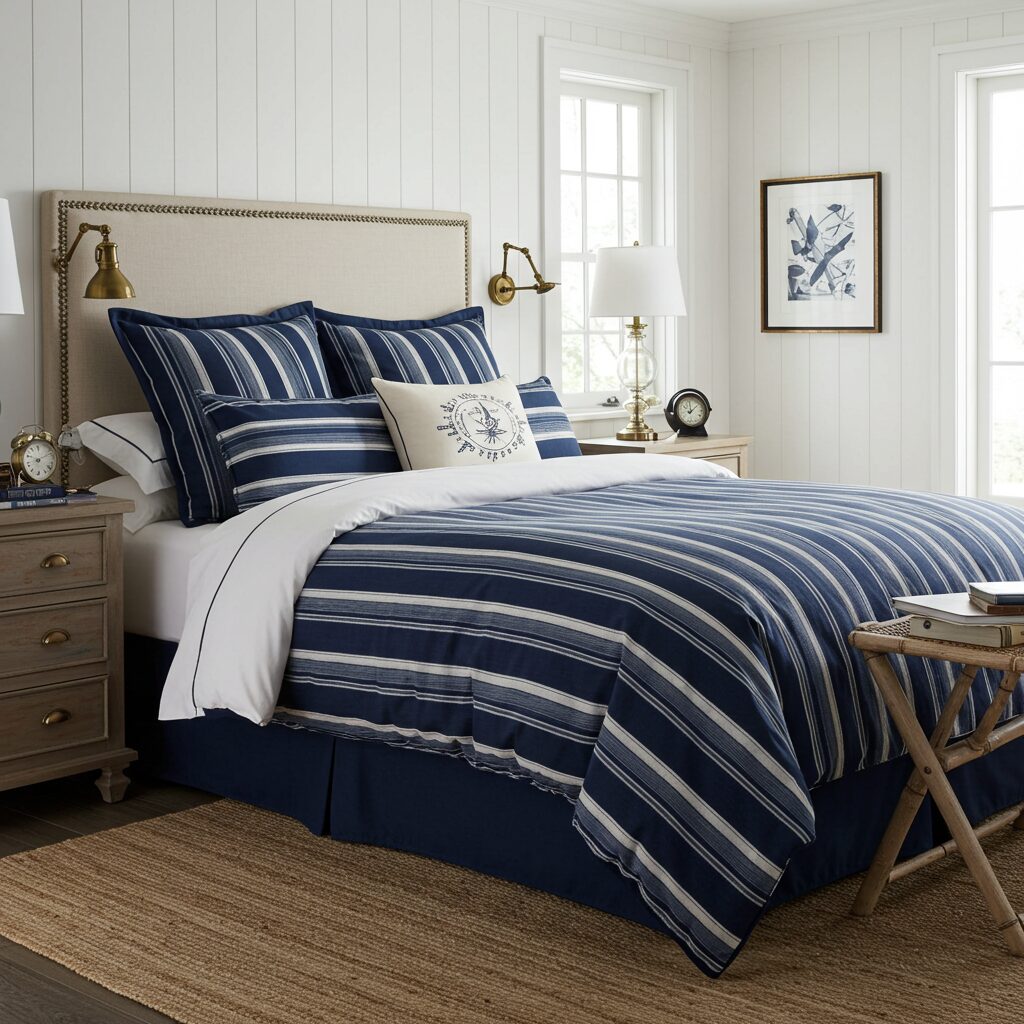
Channel maritime elegance with nautical-inspired blue and white stripes that evoke classic sailing style. This theme works beautifully in coastal homes but can add sophisticated charm to any bedroom setting. The key is choosing refined nautical elements rather than overly literal interpretations that might feel themed or childish.
Incorporate stripes through bedding, curtains, or a area rug while keeping the overall palette sophisticated with navy and crisp white. Add subtle nautical touches like rope details, brass hardware, or weathered wood accents that reference the sea without overwhelming the space. The goal is understated elegance with maritime inspiration.
Balance striped patterns with solid colors to prevent the room from feeling too busy or overwhelming. Use stripes in varying scales – perhaps wide stripes on curtains and thin stripes on pillows – to create visual interest and depth.
The secret to sophisticated nautical style is restraint – choose quality pieces with subtle references rather than obvious themed decorations.
13. Soft Periwinkle and Cream Combination

Explore the gentle beauty of periwinkle blue paired with cream for a sophisticated take on the blue and white theme. Periwinkle’s purple undertones create a unique, sophisticated color that feels both calming and elegant. This softer approach to blue and white works beautifully in romantic or traditional bedroom settings.
Cream provides a warmer alternative to stark white, creating a more intimate and cozy atmosphere while maintaining the light, airy feeling essential to the color combination. The result is a bedroom that feels both serene and welcoming, perfect for creating a peaceful retreat from daily stress.
Layer different textures in these soft hues – perhaps a periwinkle velvet throw pillow, cream linen curtains, and a soft periwinkle area rug. The subtle color variation creates depth without jarring contrasts, resulting in a harmonious and restful environment.
Periwinkle is often overlooked, but it’s one of the most flattering and calming blues for bedroom use – it works with virtually all skin tones and lighting conditions.
14. Contemporary Blue and White Geometric Patterns
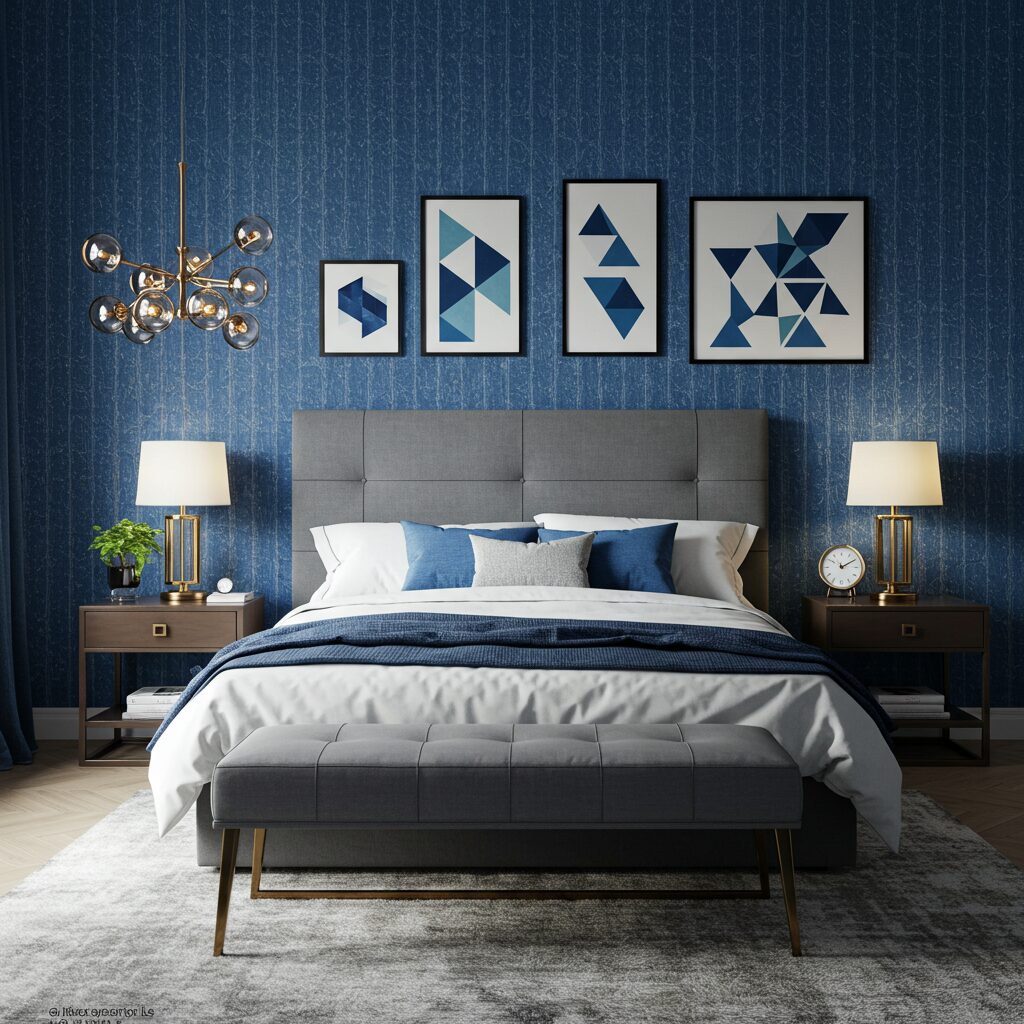
Embrace modern design with contemporary geometric patterns in blue and white that add visual interest without overwhelming the space. Geometric patterns bring energy and movement to bedrooms while maintaining the classic appeal of the blue and white color scheme. The key is choosing patterns that complement rather than compete with each other.
Consider incorporating geometric patterns through wallpaper, bedding, or artwork while keeping the overall design clean and uncluttered. Modern geometric designs work beautifully with minimalist furniture and clean lines, creating a sophisticated and current aesthetic that feels fresh and intentional.
Mix different scales of geometric patterns throughout the room – perhaps large-scale patterns on one accent wall and smaller geometric prints in pillows or throws. Ensure all patterns share the same blue and white color palette for cohesion while varying the scale and complexity for visual interest.
Pro Tip: When mixing geometric patterns, stick to the same color palette but vary the scale – use one large pattern, one medium, and one small for perfect balance.
Conclusion
The timeless combination of white and blue offers endless possibilities for creating beautiful, serene bedrooms that promote rest and relaxation. From bold navy statements to soft powder blue whispers, these fourteen ideas demonstrate the versatility and enduring appeal of this classic color pairing.
Whether you prefer the dramatic contrast of navy and white, the gentle romance of florals, or the modern sophistication of geometric patterns, there’s a blue and white bedroom style to suit every taste and decorating preference.
The key to successfully implementing any of these ideas lies in understanding proportion and balance. Use the 60-30-10 rule as your guide, allowing one color to dominate while the other provides contrast and accent opportunities.
Remember that white serves as more than just a color – it’s a tool for creating space, light, and visual breathing room that prevents blue from overwhelming your sanctuary. With careful planning and attention to detail, your blue and white bedroom will become a peaceful retreat you’ll love for years to come.